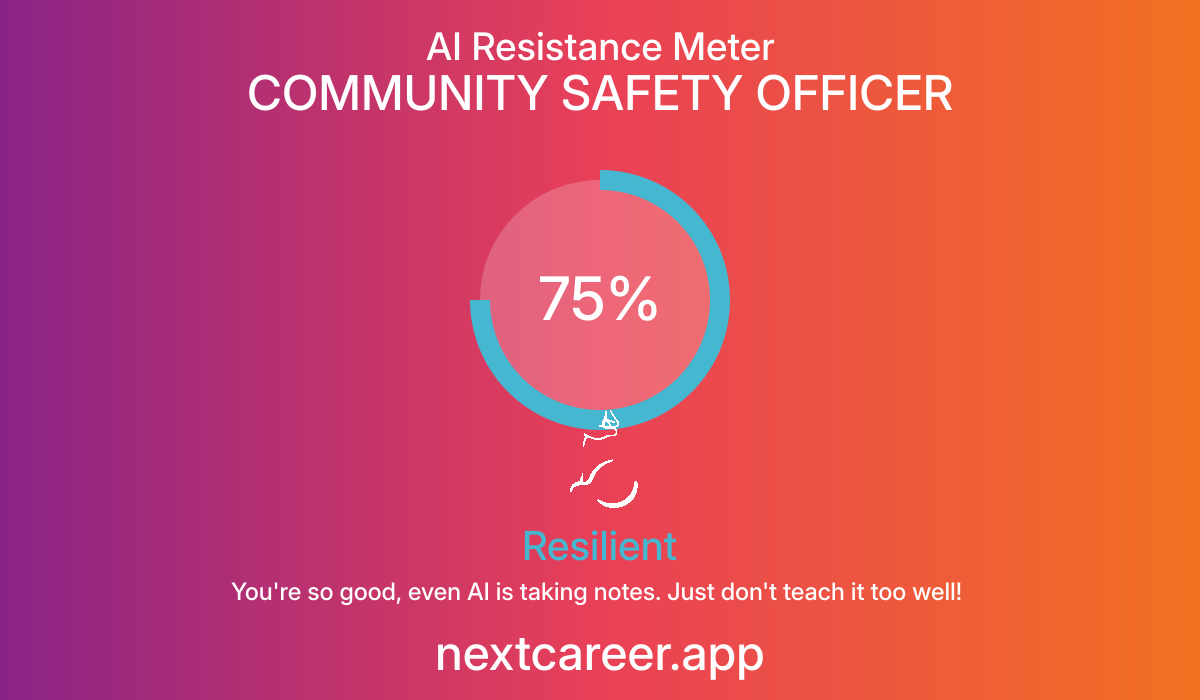AI Resistance Analysis
COMMUNITY SAFETY OFFICER
COMMUNITY SAFETY OFFICER
AI Resistance Score
AI Resistance Meter
Resilient
COMMUNITY SAFETY OFFICER
You're so good, even AI is taking notes. Just don't teach it too well!
The role of a Community Safety Officer combines various skills that involve cognitive decision-making, emotional intelligence, physical presence, and community engagement. While certain administrative tasks can be automated through AI (like data analysis or report generation), the core functions that require human interaction, understanding social dynamics, and managing crises are more challenging to replace. In the near term, AI tools may assist officers with analytics or threat assessments but will not replace the nuanced human roles completely.
The role of a Community Safety Officer combines various skills that involve cognitive decision-making, emotional intelligence, physical presence, and community engagement. While certain administrative tasks can be automated through AI (like data analysis or report generation), the core functions that require human interaction, understanding social dynamics, and managing crises are more challenging to replace. In the near term, AI tools may assist officers with analytics or threat assessments but will not replace the nuanced human roles completely.
Key Factors
- Cognitive tasks: Community Safety Officers rely on critical thinking and problem-solving skills when assessing safety issues, which AI can support, but not fully replace.
- Emotional intelligence: The ability to understand and manage human emotions is critical in community safety, making this factor a strong point against AI replacement.
- Physical skills: While AI might support surveillance and crime prediction, the physical presence and intervention by safety officers cannot be replicated.
- Creative thinking: Officers must develop proactive community safety strategies, which require creativity that AI cannot independently devise without human input.
Human Advantages
- Deep understanding of community dynamics and trust-building capabilities.
- Ability to empathize and respond to human emotions during crises.
- Adaptability to unique and varying situations that require on-the-spot judgment.
AI Vulnerabilities
- Routine reporting and administrative tasks could be automated.
- Data-driven decision support may diminish the need for some analytical roles.
Recommended Actions
- Enhance skills in emotional intelligence and community engagement through training programs.
- Incorporate AI tools for data analysis to improve operational efficiency while focusing on interpersonal aspects.
- Engage in continuous learning about emerging safety technologies and work collaboratively with tech entities to stay relevant.
In the near term, AI will be increasingly integrated into community safety systems for data analysis, risk assessment, and reporting efficiency. However, the role will evolve to focus more on community engagement, strategic planning, and crisis management. In the long term, as community values shift towards more personalized services and human connection, Community Safety Officers may find their roles expanding to include more community-oriented programs and partnerships with technology to enhance safety without losing the essential human element.

Why Calculate AI Resistance?
Understanding how AI-resistant your career is becoming increasingly important in today's rapidly evolving job market. Our analysis combines multiple factors including required human skills, technological adaptability, and future industry projections to give you a comprehensive view of your career's sustainability.